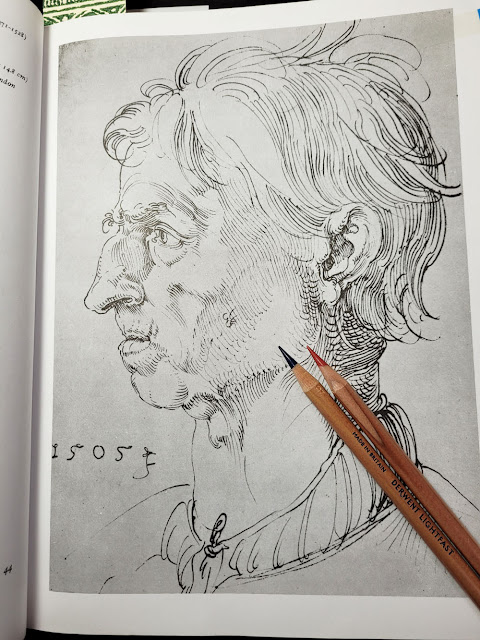 |
Hale says this about Dürer’s drawing of the ear:
“The ear is well drawn.
Get a medical anatomy book; study the helix and the
anti-helix,
the tragus and the antitragus; and you will be able to draw ears
for the rest of your life.” |
Years ago I took a pen and ink class at Gage Academy with a focus on copying masters. Each class session began with a short slideshow lecture on a period of art history and images of drawings and prints made by masters of the period. Then the assignment for the week would be to copy one or more masterwork that the instructor provided. A classic method of study, copying the works of masters helps the student to “feel” the direction and weight of lines, marks or brush strokes that were made by the artist. It’s probably a hundred times more effective as a learning tool than simply looking at a work or reading an analysis of it.
 |
As soon as I finished the nose, I saw that I got
the angle of the nostril wrong,
but I corrected it in the larger version the
next day. Trying to duplicate Dürer’s
contoured hatch marks helped me to “feel”
as well as to see
the artist’s keen knowledge of exactly how that nose was formed. |
A fascinating book recently came to my attention: Drawing Lessons from the Great Masters, by Robert Beverly Hale. Originally
published in 1964, the one I found at my library is the 45th anniversary
edition of a classic. Hale was a world-renowned teacher at the Art Students
League of New York for 40 years and a curator at the Metropolitan Museum of
Art.
The book includes a hundred figure drawings by Rembrandt, da
Vinci, Michelangelo, Dürer, Rodin and many other masters. Each work is
methodically analyzed by Hale as he explains how the artist used fundamentals
of drawing – lines, planes, mass, values, contours, etc. – to make the work.
Many examples are not finished drawings but small studies in sketchbooks, yet
they still demonstrate complete mastery of technique and understanding of
anatomy.
By following and reproducing the marks as closely as
possible, students can begin to “acquaint the subconscious mind with a certain
amount of material, so that the subconscious can largely take over the control
of our hand.” The idea is that copying masters helps us to eventually integrate
the technical skills demonstrated by those artists. It’s an ages-old method of
learning.
 |
When I took a workshop once from Melanie Reim,
she advised me
to make every mark intentional, not random. Copying this profile
drove
home that point: As I tried to follow every mark that Dürer made,
I could
see that nothing is random. Every line has an essential purpose;
no mark is wasted. My dude looks younger than Dürer’s,
and I realized it’s because
his eyelid is less droopy. A tiny detail –
yet it makes a huge difference when
trying to achieve likeness. |
Although I’m trying not to purchase more books (it’s bad
enough trying to get rid of the ones already overflowing my bookshelves), this
one will be hard to resist owning. I am trying to both read the 271-page book
and copy as many drawings as I can before the book comes due. I know I won’t
get far with the copying, but the examples shown here are how I am attacking
them: A piece at a time until I get up the gumption to do the whole drawing.
Instead of pen and ink, I’m using colored pencil.
See the image cutlines for observations from each study.
 |
| Dürer’s mastery |




I think concentrating on small parts first gave you a lot of insight to doing the full sketch. Well done.
ReplyDeleteA little less intimidating, too!
Delete